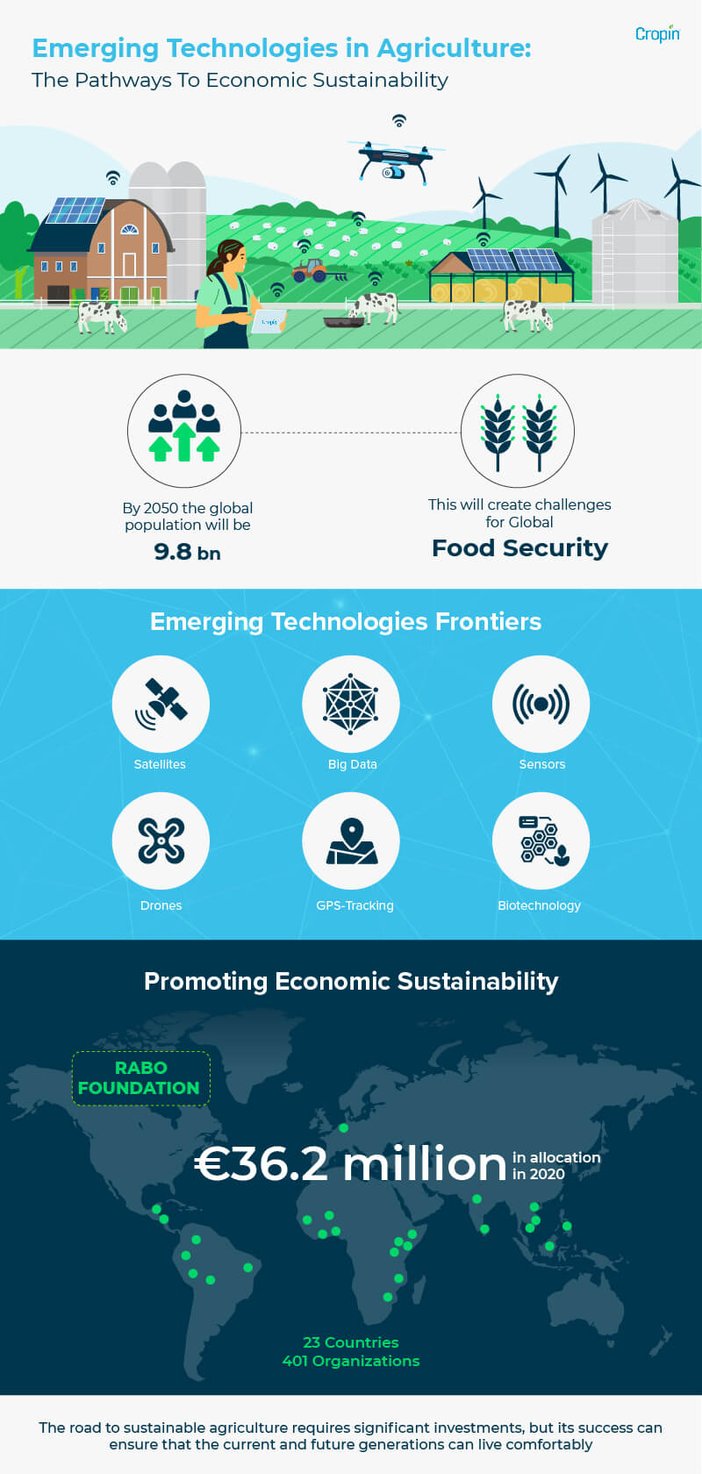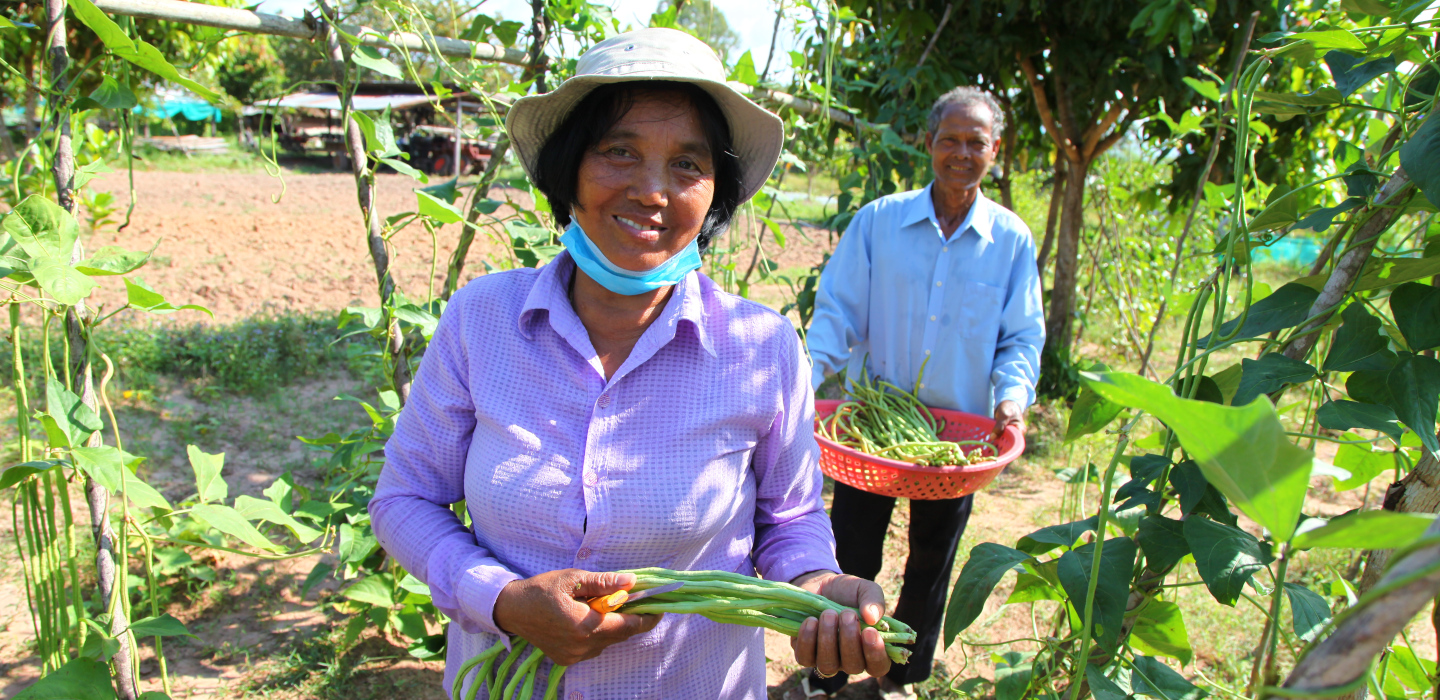Millions depend on agriculture for livelihood, yet climate change threatens food security and nutrition. Farmers can grow more food, improve resilience, reduce emissions, and boost productivity by adapting to and mitigating climate impacts.
Climate change, agriculture, and food systems are intertwined. As policymakers search for “triple wins”–practices that reduce emissions, enhance resilience or adaptation and boost productivity–it is essential to understand the synergies and tradeoffs among these three objectives.

Reducing emissions
Climate-smart agriculture is an approach to managing landscapes that help producers adapt their methods, livestock, and crops to climate change while reducing greenhouse gas emissions (GHGs). GHGs constitute a significant cause of global warming but can be mitigated through management practices like improved crop varieties, water conservation measures, and increased soil organic matter accumulation.
Agro-ecology and other climate-smart practices can also assist farmers in mitigating the effects of drought, floods, and other natural disasters by improving resilience and increasing porn. Furthermore, this approach maximizes resource efficiency – supporting economic development while decreasing greenhouse gas emissions.
In California, for instance, many farmers have implemented no-tillage systems and cover crops to reduce soil erosion and increase moisture in their crops, thus cutting back on fuel use. According to the Department of Agriculture, these climate-smart practices have reduced water erosion by 76 million tons and wind erosion by 94 million tons annually over a decade.
These climate-smart techniques not only helped farmers increase their farms’ resilience to climate change but also brought about numerous economic advantages like higher crop yields and more lucrative markets for their products. Furthermore, these practices reduce GHG emissions by 50 percent from 1990 to 2030.
Lawmakers incentivate
The United States has implemented policies promoting climate-smart agriculture (CSA) to combat climate change emissions. For instance, California encourages CSA through various incentives like carbon tax credit programs incentivizing producers to adopt practices that reduce GHG emissions.
Additionally, the U.S. government has funded numerous initiatives to develop markets for agricultural and forestry products that employ CSA-friendly production practices. These partnerships – Partnerships for Climate-Smart Commodities – aim to expand markets for American climate-smart commodities while directly benefiting farmers and ranchers.
The USDA recently invested over $3 billion into Partnerships for Climate-Smart Commodities. This program seeks to expand market access for America’s climate-smart commodities and support diverse groups of farmers, ranchers, and forest landowners. So far, the Department has assisted over 50 thousand farmers with climate-smart practices on over 20 million acres of working lands.

Adapting to climate change
Agri-food systems are highly dependent on climate and their ecosystems. That means temperature changes, CO2 levels, precipitation patterns, water availability, and other climate factors can drastically reduce crop yields. However, farmers can adapt by altering planting times, crop varieties, and water management practices.
Adaptation strategies vary and have numerous potential advantages. For instance, agroforestry can reduce soil erosion and boost crop resilience to drought. In addition, altering tillage practices can reduce CO2 emissions while improving access to climate information allows farmers to better plan their crops accordingly.
On the other hand, there is increasing interest in nature-based solutions that use the environment to boost climate resilience, known as ecosystem-based adaptation (EbA). For instance, UNEP and partners have worked hard to restore urban ecosystems to reduce flooding in Lao PDR. In contrast, the Global EbA Fund has provided grants for groundbreaking initiatives.
An alternative strategy for climate change adaptation is known as the ‘grassroots strategy,’ which involves engaging local communities and other stakeholders to share knowledge. For instance, New Zealand has seen successful role-model farmers helping neighbors cope better with drought and floods; similarly, in Niger, a farmer-led reforestation project has resulted in 10 times more trees on farms, improving soil fertility and productivity.
Adapt and overcome
Farmers’ ability to adapt to climate change depends on both their socioeconomic status and the type of agricultural system they possess. In Tanzania, households with more resources tend to invest more in adaptation measures than those with less money and land available for work.
Farmers in poorer regions often face a shortage of food to sell, so they must find ways to generate additional income. This could include diversifying their escort advisor crops or tapping into alternative sources like tourism for an additional income stream.
Climate-smart agriculture is an essential strategy for farmers to increase their incomes and address food security. In addition, it may help them avoid becoming poor since they will be more resistant to climate shocks and can produce more food.
In conclusion, climate-smart agriculture helps farmers meet various international goals, such as the Sustainable Development Goals and Paris Agreement on climate change. It emphasizes three core objectives: sustainably increasing agricultural productivity and incomes, building resilience to climate change, and reducing or eliminating greenhouse gas emissions.
Increasing productivity
Enhancing productivity is a cornerstone for creating a climate-smart agriculture future. Benefits for farmers from such practices include higher incomes, higher yields, and greater food security; they may even reduce greenhouse gas emissions or sequester carbon in the soil.
Increasing productivity for smallholders and large-scale producers is essential in today’s world of limited resources and growing demands. However, to do so, one must recognize that productivity levels will depend on factors such as crop varieties, climate conditions, and farming practices.
This can be achieved through various methods, such as using less water for crop growth, decreasing tillage and retaining residues for soil fertility, and diversifying crop rotations. In some cases, it is possible to utilize renewable energy sources or other technologies to enhance efficiency.
These methods can assist farmers in overcoming difficulties such as rising input prices, limited market access, lack of information, and inadequate infrastructure – particularly in sub-Saharan Africa, where CSA programs have traditionally been implemented.
One standard method to increase productivity is agroecology.
It promotes natural cycles and resilience among farmers by giving them better knowledge and insight into their lands and crops through research and extension programs. This can be accomplished through both traditional agricultural research and modern approaches like computerized planting systems.
In California during the 2012-2016 drought, many farmers experienced low yields, decreased crop production, and increased losses due to reduced irrigation allocations due to a lack of knowledge regarding drought-resistant and water-efficient cultivation techniques.
China has implemented a series of climate-smart agriculture projects that have enhanced the resilience of more than 44,000 hectares of farmland through innovative technologies for water management, soil condition improvement, and increased rice and maize production. These initiatives have created over 35,000 jobs and improved livelihoods for more than 29,000 farmer cooperatives.
Managing water
Water is an invaluable resource for food production and an integral component of sustainable agriculture systems. However, its withdrawal, diversion, application, and drainage have long-term consequences such as aquifer depletion, soil salinization, pollution from runoff, and climate change that affect agriculture’s water security. In addition, farming communities are becoming more vulnerable to extreme weather events that put pressure on aquifers while restricting surface water reserves.
Therefore, agricultural systems must be adapted to changing climate conditions and be able to mitigate their effects. This includes adjusting rainfall patterns, minimizing flood impacts, decreasing irrigation needs, and optimizing water-use processes for maximum efficiency.
Furthermore, agri-water management strategies can increase resilience to climate variability, enhance crop productivity and reduce greenhouse gas emissions. This can be accomplished through improved crop and agri-water practices such as implementing water conservation measures, managing nutrient losses, or improving soil moisture, among other criteria.

Agri-water management
Another way to secure water is through water-efficient agriculture practices like solar energy or rainwater harvesting. In certain countries, such as Ethiopia, these practices have been known to improve crop productivity by 20-30% and boost food security by providing access to land for growing vegetables while limiting environmental effects.
For example, agri-voltaics can supply renewable electricity to power small-scale irrigation and allow farmers to grow crops that will survive dry spells and generate additional income than they otherwise would. In Texas, CCAFS is working with partners in the Rio Grande Valley to pilot agrivoltaics and assist Hispanic buffalo producers in developing climate-smart markets.
NRCS also encourages agricultural practices that conserve water and promote climate-smart agri-food systems. Recently, the agency announced $850 million in the fiscal year 2023 funding opportunities for producers and communities throughout the West who want to adopt sustainable agriculture and conservation methods.
Given the increasing water demands, agricultural production practices must be adjusted to changing climate conditions and integrated into new agri-food system design. An in-depth knowledge of local climate conditions and an extensive analysis of climate change impacts on water availability, soil moisture, crop performance, and profitability must be conducted to develop such strategies. This insight allows the development of systems that capitalize on benefits while minimizing their effects on land and ecosystems.








 Moderator Linidiwe Sibanda expressed her frustration on agriculture not being considered vital enough for a work program at multiple times at the Agriculture, Landscapes and Livelihoods Day 5. The ALL5 Day was recently held in Qatar, in parallel with the climate conference COP18, gathering hundreds of participants, both online and on site.
Moderator Linidiwe Sibanda expressed her frustration on agriculture not being considered vital enough for a work program at multiple times at the Agriculture, Landscapes and Livelihoods Day 5. The ALL5 Day was recently held in Qatar, in parallel with the climate conference COP18, gathering hundreds of participants, both online and on site.